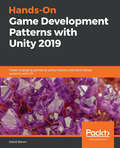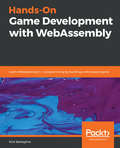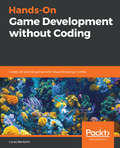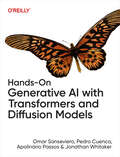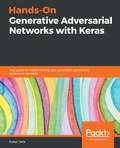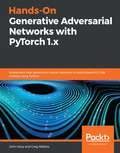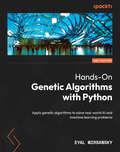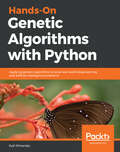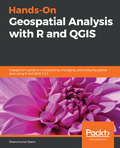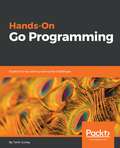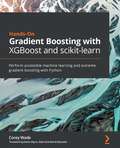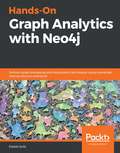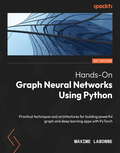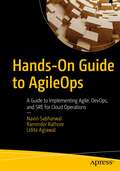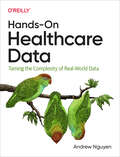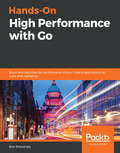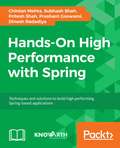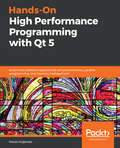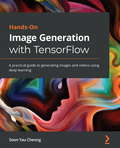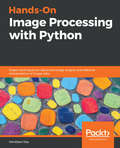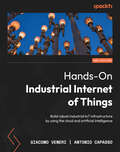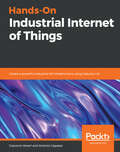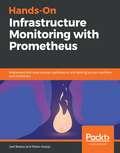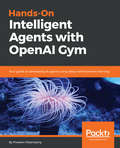- Table View
- List View
Hands-On Game Development Patterns with Unity 2019: Create engaging games by using industry-standard design patterns with C#
by David BaronWrite maintainable, fault-tolerant, and cleaner game codes by understanding the standard development patterns and battle-tested practices. Key Features Gain expertise in Industry Standard design patterns. Get your hands on popular patterns such as Observer, Singleton, State, and Factory. Leverage the power of C# coding to create solid architectures for your game projects. Book Description Traditional building blocks of a robust architecture, such as design patterns, cannot be applied in Unity without being adapted to the Engine's unique way of doing things. We will review design patterns that are currently used by professional game programmers in indie, mobile, and AAA studios. We will also examine the infamous anti-patterns. The book begins by explaining Unity Engine's architecture and shows you how to explore it for designing games. This will help readers get familiar with the pillars of Unity's Engine architecture and assist them in making better technical decisions. We will then learn about the game industry's most popular software design patterns. Right from the initial concept up to its implementation, you'll learn every detail in the context of genuine industry use cases that game programmers often deal with in the field. This approach will be a onestop reference point and will give you a complete picture of tried and tested software development patterns with Unity using C#. We will review classic patterns such as Singleton; modern patterns such as Event Bus; and even rare patterns such as the Spatial Partition. The book concludes by covering the dark side of design patterns, by exposing recognizable patterns that tend to creep out in code bases and have unexpected negative side-effects. What you will learn Discover the core architectural pillars of the Unity game engine. Learn about software design patterns while building gameplay systems. Acquire the skills to recognize anti-patterns and how to avoid their adverse effect in your codebase. Enrich your design vocabulary so you can better articulate your ideas on how to better your game's architecture. Gain some mastery over Unity's API by writing well-designed code. Get some game industry insider tips and tricks that will help you in your career. Who this book is for The ideal target audience for this book is game developers who want to get their hands on industry-standard, software development patterns and techniques to create engaging and exciting games with Unity 2018. Basic Unity development knowledge is necessary to make the most out of this book. Prior experience with C# will also be helpful
Hands-On Game Development with WebAssembly: Learn WebAssembly C++ programming by building a retro space game
by Rick BattaglineMake your WebAssembly journey fun while making a game with itKey FeaturesCreate a WebAssembly game that implements sprites, animations, physics, particle systems, and other game development fundamentalsGet to grips with advanced game mechanics in WebAssemblyLearn to use WebAssembly and WebGL to render to the HTML5 canvas elementBook DescriptionWithin the next few years, WebAssembly will change the web as we know it. It promises a world where you can write an application for the web in any language, and compile it for native platforms as well as the web.This book is designed to introduce web developers and game developers to the world of WebAssembly by walking through the development of a retro arcade game. You will learn how to build a WebAssembly application using C++, Emscripten, JavaScript, WebGL, SDL, and HTML5.This book covers a lot of ground in both game development and web application development. When creating a game or application that targets WebAssembly, developers need to learn a plethora of skills and tools. This book is a sample platter of those tools and skills. It covers topics including Emscripten, C/C++, WebGL, OpenGL, JavaScript, HTML5, and CSS. The reader will also learn basic techniques for game development, including 2D sprite animation, particle systems, 2D camera design, sound effects, 2D game physics, user interface design, shaders, debugging, and optimization. By the end of the book, you will be able to create simple web games and web applications targeting WebAssembly.What you will learnBuild web applications with near-native performance using WebAssemblyBecome familiar with how web applications can be used to create games using HTML5 Canvas, WebGL, and SDLBecome well versed with game development concepts such as sprites, animation, particle systems, AI, physics, camera design, sound effects, and shadersDeploy C/C++ applications to the browser using WebAssembly and EmscriptenUnderstand how Emscripten HTML shell templates, JavaScript glue code, and a WebAssembly module interactDebug and performance tune your WebAssembly applicationWho this book is forWeb developers and game developers interested in creating applications for the web using WebAssembly.Game developers interested in deploying their games to the webWeb developers interested in creating applications that are potentially orders of magnitude faster than their existing JavaScript web appsC/C++ developers interested in using their existing skills to deploy applications to the web
Hands-On Game Development without Coding: Create 2D and 3D games with Visual Scripting in Unity
by Lucas BertoliniDevelop your own games with Unity 2D/3D Game Kit and use it for your presentations, kids education, level design, game design, proofs of concept, or even just for fun!Key FeaturesBuild your first ever video game using Unity 2D/3D Game kitLearn how to create game levels, adding props, giving behaviours to objects and working on gameplayStep by step instructions on creating your own AI enemy and interacting with itBook DescriptionHands-On Game Development without Coding is the first Visual Scripting book in the market. It was tailor made for a non programing audience who are wondering how a videogame is made.After reading this book you will be able to develop your own 2d and 3d videogames and use it on your presentations, to speed up your level design deliveries, test your game design ideas, work on your proofs of concept, or even doing it just for fun.The best thing about Hands-On Game Development without Coding is that you don’t need any previous knowledge to read and understand the process of creating a videogame. It is our main focus to provide you with the opportunity to create a videogame as easy and fast as possible.Once you go through the book, you will be able to create player input interaction, levels, object behaviours, enemy AI, creating your own UI and finally giving life to your game by building it.It’s Alive!What you will learnUnderstanding the Interface and kit flow. Comprehend the virtual space and its rules.Learning the behaviours and roles each component must have in order to make a videogame.Learn about videogame developmentCreating a videogame without the need of learning any programming languageCreate your own gameplay HUD to display player and Enemy informationWho this book is forThis book is for anyone who is interested in becoming a game developer but do not posses any coding experience or programming skills. All you need is a computer and basic software interface knowledge.
Hands-On Generative AI with Transformers and Diffusion Models
by Pedro Cuenca Omar Sanseviero Apolinário Passos Jonathan WhitakerLearn to use generative AI techniques to create novel text, images, audio, and even music with this practical, hands-on book. Readers will understand how state-of-the-art generative models work, how to fine-tune and adapt them to their needs, and how to combine existing building blocks to create new models and creative applications in different domains.This go-to book introduces theoretical concepts followed by guided practical applications, with extensive code samples and easy-to-understand illustrations. You'll learn how to use open source libraries to utilize transformers and diffusion models, conduct code exploration, and study several existing projects to help guide your work.Build and customize models that can generate text and imagesExplore trade-offs between using a pretrained model and fine-tuning your own modelCreate and utilize models that can generate, edit, and modify images in any styleCustomize transformers and diffusion models for multiple creative purposesTrain models that can reflect your own unique style
Hands-On Generative Adversarial Networks with Keras: Your guide to implementing next-generation generative adversarial networks
by Rafael ValleDevelop generative models for a variety of real-world use-cases and deploy them to productionKey FeaturesDiscover various GAN architectures using Python and Keras libraryUnderstand how GAN models function with the help of theoretical and practical examplesApply your learnings to become an active contributor to open source GAN applicationsBook DescriptionGenerative Adversarial Networks (GANs) have revolutionized the fields of machine learning and deep learning. This book will be your first step towards understanding GAN architectures and tackling the challenges involved in training them.This book opens with an introduction to deep learning and generative models, and their applications in artificial intelligence (AI). You will then learn how to build, evaluate, and improve your first GAN with the help of easy-to-follow examples. The next few chapters will guide you through training a GAN model to produce and improve high-resolution images. You will also learn how to implement conditional GANs that give you the ability to control characteristics of GAN outputs. You will build on your knowledge further by exploring a new training methodology for progressive growing of GANs. Moving on, you'll gain insights into state-of-the-art models in image synthesis, speech enhancement, and natural language generation using GANs. In addition to this, you'll be able to identify GAN samples with TequilaGAN.By the end of this book, you will be well-versed with the latest advancements in the GAN framework using various examples and datasets, and you will have the skills you need to implement GAN architectures for several tasks and domains, including computer vision, natural language processing (NLP), and audio processing.What you will learnLearn how GANs work and the advantages and challenges of working with themControl the output of GANs with the help of conditional GANs, using embedding and space manipulationApply GANs to computer vision, NLP, and audio processingUnderstand how to implement progressive growing of GANsUse GANs for image synthesis and speech enhancementExplore the future of GANs in visual and sonic artsImplement pix2pixHD to turn semantic label maps into photorealistic imagesWho this book is forThis book is for machine learning practitioners, deep learning researchers, and AI enthusiasts who are looking for a perfect mix of theory and hands-on content in order to implement GANs using Keras. Working knowledge of Python is expected.
Hands-On Generative Adversarial Networks with PyTorch 1.x: Implement next-generation neural networks to build powerful GAN models using Python
by John Hany Greg WaltersApply deep learning techniques and neural network methodologies to build, train, and optimize generative network models Key Features Implement GAN architectures to generate images, text, audio, 3D models, and more Understand how GANs work and become an active contributor in the open source community Learn how to generate photo-realistic images based on text descriptions Book Description With continuously evolving research and development, Generative Adversarial Networks (GANs) are the next big thing in the field of deep learning. This book highlights the key improvements in GANs over generative models and guides in making the best out of GANs with the help of hands-on examples. This book starts by taking you through the core concepts necessary to understand how each component of a GAN model works. You'll build your first GAN model to understand how generator and discriminator networks function. As you advance, you'll delve into a range of examples and datasets to build a variety of GAN networks using PyTorch functionalities and services, and become well-versed with architectures, training strategies, and evaluation methods for image generation, translation, and restoration. You'll even learn how to apply GAN models to solve problems in areas such as computer vision, multimedia, 3D models, and natural language processing (NLP). The book covers how to overcome the challenges faced while building generative models from scratch. Finally, you'll also discover how to train your GAN models to generate adversarial examples to attack other CNN and GAN models. By the end of this book, you will have learned how to build, train, and optimize next-generation GAN models and use them to solve a variety of real-world problems. What you will learn Implement PyTorch's latest features to ensure efficient model designing Get to grips with the working mechanisms of GAN models Perform style transfer between unpaired image collections with CycleGAN Build and train 3D-GANs to generate a point cloud of 3D objects Create a range of GAN models to perform various image synthesis operations Use SEGAN to suppress noise and improve the quality of speech audio Who this book is for This GAN book is for machine learning practitioners and deep learning researchers looking to get hands-on guidance in implementing GAN models using PyTorch. You'll become familiar with state-of-the-art GAN architectures with the help of real-world examples. Working knowledge of Python programming language is necessary to grasp the concepts covered in this book.
Hands-On Genetic Algorithms with Python: Apply genetic algorithms to solve real-world AI and machine learning problems
by Eyal WirsanskyExplore the ever-growing world of genetic algorithms to build and enhance AI applications involving search, optimization, machine learning, deep learning, NLP, and XAI using Python librariesKey FeaturesLearn how to implement genetic algorithms using Python libraries DEAP, scikit-learn, and NumPyTake advantage of cloud computing technology to increase the performance of your solutionsDiscover bio-inspired algorithms such as particle swarm optimization (PSO) and NEATPurchase of the print or Kindle book includes a free PDF eBookBook DescriptionWritten by Eyal Wirsansky, a senior data scientist and AI researcher with over 25 years of experience and a research background in genetic algorithms and neural networks, Hands-On Genetic Algorithms with Python offers expert insights and practical knowledge to master genetic algorithms. After an introduction to genetic algorithms and their principles of operation, you’ll find out how they differ from traditional algorithms and the types of problems they can solve, followed by applying them to search and optimization tasks such as planning, scheduling, gaming, and analytics. As you progress, you’ll delve into explainable AI and apply genetic algorithms to AI to improve machine learning and deep learning models, as well as tackle reinforcement learning and NLP tasks. This updated second edition further expands on applying genetic algorithms to NLP and XAI and speeding up genetic algorithms with concurrency and cloud computing. You’ll also get to grips with the NEAT algorithm. The book concludes with an image reconstruction project and other related technologies for future applications. By the end of this book, you’ll have gained hands-on experience in applying genetic algorithms across a variety of fields, with emphasis on artificial intelligence with Python.What you will learnUse genetic algorithms to solve planning, scheduling, gaming, and analytics problemsCreate reinforcement learning, NLP, and explainable AI applicationsEnhance the performance of ML models and optimize deep learning architectureDeploy genetic algorithms using client-server architectures, enhancing scalability and computational efficiencyExplore how images can be reconstructed using a set of semi-transparent shapesDelve into topics like elitism, niching, and multiplicity in genetic solutions to enhance optimization strategies and solution diversityWho this book is forIf you’re a data scientist, software developer, AI enthusiast who wants to break into the world of genetic algorithms and apply them to real-world, intelligent applications as quickly as possible, this book is for you. Working knowledge of the Python programming language is required to get started with this book.
Hands-On Genetic Algorithms with Python: Applying genetic algorithms to solve real-world deep learning and artificial intelligence problems
by Eyal WirsanskyExplore the ever-growing world of genetic algorithms to solve search, optimization, and AI-related tasks, and improve machine learning models using Python libraries such as DEAP, scikit-learn, and NumPy Key Features Explore the ins and outs of genetic algorithms with this fast-paced guide Implement tasks such as feature selection, search optimization, and cluster analysis using Python Solve combinatorial problems, optimize functions, and enhance the performance of artificial intelligence applications Book Description Genetic algorithms are a family of search, optimization, and learning algorithms inspired by the principles of natural evolution. By imitating the evolutionary process, genetic algorithms can overcome hurdles encountered in traditional search algorithms and provide high-quality solutions for a variety of problems. This book will help you get to grips with a powerful yet simple approach to applying genetic algorithms to a wide range of tasks using Python, covering the latest developments in artificial intelligence. After introducing you to genetic algorithms and their principles of operation, you'll understand how they differ from traditional algorithms and what types of problems they can solve. You'll then discover how they can be applied to search and optimization problems, such as planning, scheduling, gaming, and analytics. As you advance, you'll also learn how to use genetic algorithms to improve your machine learning and deep learning models, solve reinforcement learning tasks, and perform image reconstruction. Finally, you'll cover several related technologies that can open up new possibilities for future applications. By the end of this book, you'll have hands-on experience of applying genetic algorithms in artificial intelligence as well as in numerous other domains. What you will learn Understand how to use state-of-the-art Python tools to create genetic algorithm-based applications Use genetic algorithms to optimize functions and solve planning and scheduling problems Enhance the performance of machine learning models and optimize deep learning network architecture Apply genetic algorithms to reinforcement learning tasks using OpenAI Gym Explore how images can be reconstructed using a set of semi-transparent shapes Discover other bio-inspired techniques, such as genetic programming and particle swarm optimization Who this book is for This book is for software developers, data scientists, and AI enthusiasts who want to use genetic algorithms to carry out intelligent tasks in their applications. Working knowledge of Python and basic knowledge of mathematics and computer science will help you get the most out of this book.
Hands-On Genetic Algorithms with Python: Applying genetic algorithms to solve real-world deep learning and artificial intelligence problems
by Eyal WirsanskyExplore the ever-growing world of genetic algorithms to solve search, optimization, and AI-related tasks, and improve machine learning models using Python libraries such as DEAP, scikit-learn, and NumPyKey FeaturesExplore the ins and outs of genetic algorithms with this fast-paced guideImplement tasks such as feature selection, search optimization, and cluster analysis using PythonSolve combinatorial problems, optimize functions, and enhance the performance of artificial intelligence applicationsBook DescriptionGenetic algorithms are a family of search, optimization, and learning algorithms inspired by the principles of natural evolution. By imitating the evolutionary process, genetic algorithms can overcome hurdles encountered in traditional search algorithms and provide high-quality solutions for a variety of problems. This book will help you get to grips with a powerful yet simple approach to applying genetic algorithms to a wide range of tasks using Python, covering the latest developments in artificial intelligence. After introducing you to genetic algorithms and their principles of operation, you'll understand how they differ from traditional algorithms and what types of problems they can solve. You'll then discover how they can be applied to search and optimization problems, such as planning, scheduling, gaming, and analytics. As you advance, you'll also learn how to use genetic algorithms to improve your machine learning and deep learning models, solve reinforcement learning tasks, and perform image reconstruction. Finally, you'll cover several related technologies that can open up new possibilities for future applications. By the end of this book, you'll have hands-on experience of applying genetic algorithms in artificial intelligence as well as in numerous other domains.What you will learnUnderstand how to use state-of-the-art Python tools to create genetic algorithm-based applicationsUse genetic algorithms to optimize functions and solve planning and scheduling problemsEnhance the performance of machine learning models and optimize deep learning network architectureApply genetic algorithms to reinforcement learning tasks using OpenAI GymExplore how images can be reconstructed using a set of semi-transparent shapesDiscover other bio-inspired techniques, such as genetic programming and particle swarm optimizationWho this book is forThis book is for software developers, data scientists, and AI enthusiasts who want to use genetic algorithms to carry out intelligent tasks in their applications. Working knowledge of Python and basic knowledge of mathematics and computer science will help you get the most out of this book.
Hands-On Geospatial Analysis with R and QGIS: A beginner’s guide to manipulating, managing, and analyzing spatial data using R and QGIS 3.2.2
by Shammunul IslamPractical examples with real-world projects in GIS, Remote sensing, Geospatial data management and Analysis using the R programming languageKey FeaturesUnderstand the basics of R and QGIS to work with GIS and remote sensing dataLearn to manage, manipulate, and analyze spatial data using R and QGISApply machine learning algorithms to geospatial data using R and QGISBook DescriptionManaging spatial data has always been challenging and it's getting more complex as the size of data increases. Spatial data is actually big data and you need different tools and techniques to work your way around to model and create different workflows. R and QGIS have powerful features that can make this job easier.This book is your companion for applying machine learning algorithms on GIS and remote sensing data. You’ll start by gaining an understanding of the nature of spatial data and installing R and QGIS. Then, you’ll learn how to use different R packages to import, export, and visualize data, before doing the same in QGIS. Screenshots are included to ease your understanding.Moving on, you’ll learn about different aspects of managing and analyzing spatial data, before diving into advanced topics. You’ll create powerful data visualizations using ggplot2, ggmap, raster, and other packages of R. You’ll learn how to use QGIS 3.2.2 to visualize and manage (create, edit, and format) spatial data. Different types of spatial analysis are also covered using R. Finally, you’ll work with landslide data from Bangladesh to create a landslide susceptibility map using different machine learning algorithms.By reading this book, you’ll transition from being a beginner to an intermediate user of GIS and remote sensing data in no time.What you will learnInstall R and QGISGet familiar with the basics of R programming and QGISVisualize quantitative and qualitative data to create mapsFind out the basics of raster data and how to use them in R and QGISPerform geoprocessing tasks and automate them using the graphical modeler of QGISApply different machine learning algorithms on satellite data for landslide susceptibility mapping and predictionWho this book is forThis book is great for geographers, environmental scientists, statisticians, and every professional who deals with spatial data. If you want to learn how to handle GIS and remote sensing data, then this book is for you. Basic knowledge of R and QGIS would be helpful but is not necessary.
Hands-On Go Programming: Explore Go by solving real-world challenges
by Tarik GuneyLearn Go programming with concise examples providing solutions to many common fundamental problems.Key FeaturesGet comfortable with Go through short, independent, and concise recipesOvercome the most common challenges in Go with practical solutionsTake advantage of the most exciting features of Go such as GoroutinesBook DescriptionGo has become increasingly popular. C-like speed, simplicity, and power for a growing number of system-level programming domains make it an attractive option for programmers. This book will help you learn the Go programming language by solving problems developers commonly face with a recipe approach. You’ll start by installing Go binaries and get familiar with the tools needed to develop an application. Then you’ll manipulate with strings and use them in built-in function constructs to create a complex value from two floating-point values. Next, you’ll learn how to perform arithmetic operations with date and time values, along with parsing them from string values. Whether you’re an expert programmer or a fresh starter, you will learn how various answers are programmed in the Go language, which will take you to the next level of mastery with Go. We cover concurrency in Go, performing various web programming tasks, doing system programming, reading and writing files, and many fundamental Go programming skills, such as proper error handling, and logging.What you will learnConvert types from one to anotherWork with dates and timesWork with maps and arraysHandle errors and perform loggingWork with files and directoriesHandle HTTP request and responsesPerform CRUD operations on a relational databaseWho this book is forThis book caters to software developers who are interested in learning the Go language, and programmers who want to move forward with practical code examples.
Hands-On Gradient Boosting with XGBoost and scikit-learn: Perform Accessible Machine Learning And Extreme Gradient Boosting With Python
by Corey WadeThis book is for data science professionals and enthusiasts, data analysts, and developers who want to build fast and accurate machine learning models that scale with big data. Proficiency in Python and a basic understanding of linear algebra will help you to get the most out of this book.
Hands-On Graph Analytics with Neo4j: Perform graph processing and visualization techniques using connected data across your enterprise
by Estelle ScifoThis book is for data analysts, business analysts, graph analysts, and database developers looking to store and process graph data to reveal key data insights. This book will also appeal to data scientists who want to build intelligent graph applications catering to different domains. Some experience with Neo4j is required.
Hands-On Graph Neural Networks Using Python: Practical techniques and architectures for building powerful graph and deep learning apps with PyTorch
by Maxime LabonneDesign robust graph neural networks with PyTorch Geometric by combining graph theory and neural networks with the latest developments and appsPurchase of the print or Kindle book includes a free PDF eBookKey FeaturesImplement state-of-the-art graph neural network architectures in PythonCreate your own graph datasets from tabular dataBuild powerful traffic forecasting, recommender systems, and anomaly detection applicationsBook DescriptionGraph neural networks are a highly effective tool for analyzing data that can be represented as a graph, such as social networks, chemical compounds, or transportation networks. The past few years have seen an explosion in the use of graph neural networks, with their application ranging from natural language processing and computer vision to recommendation systems and drug discovery.Hands-On Graph Neural Networks Using Python begins with the fundamentals of graph theory and shows you how to create graph datasets from tabular data. As you advance, you'll explore major graph neural network architectures and learn essential concepts such as graph convolution, self-attention, link prediction, and heterogeneous graphs. Finally, the book proposes applications to solve real-life problems, enabling you to build a professional portfolio. The code is readily available online and can be easily adapted to other datasets and apps.By the end of this book, you'll have learned to create graph datasets, implement graph neural networks using Python and PyTorch Geometric, and apply them to solve real-world problems, along with building and training graph neural network models for node and graph classification, link prediction, and much more.What you will learnUnderstand the fundamental concepts of graph neural networksImplement graph neural networks using Python and PyTorch GeometricClassify nodes, graphs, and edges using millions of samplesPredict and generate realistic graph topologiesCombine heterogeneous sources to improve performanceForecast future events using topological informationApply graph neural networks to solve real-world problemsWho this book is forThis book is for machine learning practitioners and data scientists interested in learning about graph neural networks and their applications, as well as students looking for a comprehensive reference on this rapidly growing field. Whether you're new to graph neural networks or looking to take your knowledge to the next level, this book has something for you. Basic knowledge of machine learning and Python programming will help you get the most out of this book.
Hands-On Guide to AgileOps: A Guide to Implementing Agile, DevOps, and SRE for Cloud Operations
by Navin Sabharwal Raminder Rathore Udita AgrawalDiscover the best practices for transforming cloud and infrastructure operations by using Agile, Scrum, Kanban, Scrumban and Spotify models. This book will help you gain an in-depth understanding of these processes so that you can apply them to your own work. The book begins by offering an overview of current processes and methods used in IT Operations using ITIL and IT4IT. The Authors provide a background of the Agile, Scrum, Kanban, SaFe, Scrumban, and Spotify models used in software development. You’ll then gain in-depth guidance and best practices to implement Agile in the Operations world. You’ll see how Agile, Site Reliability Engineering and DevOps work in tandem to provide the foundation for modern day infrastructure and cloud operations. The book also offers a comparison of various agile processes and their suitability to the infrastructure and cloud operations world. After completing this is hands-on guide, you’ll know how to adopt Agile, DevOps and SRE and select the most suitable processes for your organization to achieve higher reliability, agility and lower costs while running cloud and infrastructure operations. What You Will LearnUnderstand how cloud computing and microservices architecture are changing operations dynamicsUnderstand ITIL, IT4IT, and LeanLearn how Site Reliability Engineering, Agile and DevOps work in tandemLeverage Agile, Scrum, Kanban, Scrumban, and Spotify models to run cloud operationsUse Site Reliability techniques along with Agile and DevOpsStudy the different agile frameworks (Spotify, SAFe, LeSS, DAD, Nexus), their purpose, benefits and implementation approaches.Learn a step-by-step process to identify and implement these frameworks in your organization Who This Book is For Infrastructure architects, DevOps architects, Agile practitioners, DevSecOps Experts, Product Managers/Scrum Masters, DevOps Engineers.
Hands-On Healthcare Data: Taming the Complexity of Real-World Data
by Andrew NguyenHealthcare is the next frontier for data science. Using the latest in machine learning, deep learning, and natural language processing, you'll be able to solve healthcare's most pressing problems: reducing cost of care, ensuring patients get the best treatment, and increasing accessibility for the underserved. But first, you have to learn how to access and make sense of all that data.This book provides pragmatic and hands-on solutions for working with healthcare data, from data extraction to cleaning and harmonization to feature engineering. Author Andrew Nguyen covers specific ML and deep learning examples with a focus on producing high-quality data. You'll discover how graph technologies help you connect disparate data sources so you can solve healthcare's most challenging problems using advanced analytics.You'll learn:Different types of healthcare data: electronic health records, clinical registries and trials, digital health tools, and claims dataThe challenges of working with healthcare data, especially when trying to aggregate data from multiple sourcesCurrent options for extracting structured data from clinical textHow to make trade-offs when using tools and frameworks for normalizing structured healthcare dataHow to harmonize healthcare data using terminologies, ontologies, and mappings and crosswalks
Hands-On High Performance with Go: Boost and optimize the performance of your Golang applications at scale with resilience
by Bob StrecanskyProven methodologies and concurrency techniques that will help you write faster and better code with Go programming Key Features Explore Go's profiling tools to write faster programs by identifying and fixing bottlenecks Address Go-specific performance issues such as memory allocation and garbage collection Delve into the subtleties of concurrency and discover how to successfully implement it in everyday applications Book Description Go is an easy-to-write language that is popular among developers thanks to its features such as concurrency, portability, and ability to reduce complexity. This Golang book will teach you how to construct idiomatic Go code that is reusable and highly performant. Starting with an introduction to performance concepts, you'll understand the ideology behind Go's performance. You'll then learn how to effectively implement Go data structures and algorithms along with exploring data manipulation and organization to write programs for scalable software. This book covers channels and goroutines for parallelism and concurrency to write high-performance code for distributed systems. As you advance, you'll learn how to manage memory effectively. You'll explore the compute unified device architecture (CUDA) application programming interface (API), use containers to build Go code, and work with the Go build cache for quicker compilation. You'll also get to grips with profiling and tracing Go code for detecting bottlenecks in your system. Finally, you'll evaluate clusters and job queues for performance optimization and monitor the application for performance regression. By the end of this Go programming book, you'll be able to improve existing code and fulfill customer requirements by writing efficient programs. What you will learn Organize and manipulate data effectively with clusters and job queues Explore commonly applied Go data structures and algorithms Write anonymous functions in Go to build reusable apps Profile and trace Go apps to reduce bottlenecks and improve efficiency Deploy, monitor, and iterate Go programs with a focus on performance Dive into memory management and CPU and GPU parallelism in Go Who this book is for This Golang book is a must for developers and professionals who have an intermediate-to-advanced understanding of Go programming, and are interested in improving their speed of code execution.
Hands-On High Performance with Spring 5: Techniques for scaling and optimizing Spring and Spring Boot applications
by Chintan Mehta Subhash Shah Pritesh Shah Prashant Goswami Dinesh RadadiyaA hands-on guide to creating, monitoring, and tuning a high performance Spring web applicationKey FeaturesUnderstand common performance pitfalls and improve your application's performanceBuild and deploy strategies for complex applications using the microservice architectureUnderstand internals of JVM - the core of all Java Runtime EnvironmentsBook DescriptionWhile writing an application, performance is paramount. Performance tuning for real-world applications often involves activities geared toward detecting bottlenecks. The recent release of Spring 5.0 brings major advancements in the rich API provided by the Spring framework, which means developers need to master its tools and techniques to achieve high performance applications.Hands-On High Performance with Spring 5 begins with the Spring framework's core features, exploring the integration of different Spring projects. It proceeds to evaluate various Spring specifications to identify those adversely affecting performance. You will learn about bean wiring configurations, aspect-oriented programming, database interaction, and Hibernate to focus on the metrics that help identify performance bottlenecks. You will also look at application monitoring, performance optimization, JVM internals, and garbage collection optimization. Lastly, the book will show you how to leverage the microservice architecture to build a high performance and resilient application.By the end of the book, you will have gained an insight into various techniques and solutions to build and troubleshoot high performance Spring-based applications.What you will learnMaster programming best practices and performance improvement with bean wiringAnalyze the performance of various AOP implementationsExplore database interactions with Spring to optimize design and configurationSolve Hibernate performance issues and trapsLeverage multithreading and concurrent programming to improve application performanceGain a solid foundation in JVM performance tuning using various toolsLearn the key concepts of the microservice architecture and how to monitor themPerform Spring Boot performance tuning, monitoring, and health checksWho this book is forIf you’re a Spring developer who’d like to build high performance applications and have more control over your application's performance in production and development, this book is for you. Some familiarity with Java, Maven, and Eclipse is necessary.
Hands-On High performance with QT: Build cross-platform applications using concurrency, parallel programming, and memory management
by Marek KrajewskiThis book for Qt developers who wish to build highly performant applications for desktop and embedded devices, and have C++ knowledge.
Hands-On Image Generation with TensorFlow
by Soon Yau CheongThe Hands-On Image Generation with TensorFlow book is for deep learning engineers, practitioners, and researchers who have basic knowledge of convolutional neural networks and want to learn various image generation techniques using TensorFlow 2.x. You’ll also find this book useful if you are an image processing professional or computer vision engineer looking to explore state-of-the-art architectures to improve and enhance images and videos. Knowledge of Python and TensorFlow will help you to get the best out of this book.
Hands-On Image Processing with Python: Expert techniques for advanced image analysis and effective interpretation of image data
by Sandipan DeyThis book is for Computer Vision Engineers, Image processing Engineers, Software Engineers, ML Engineers who are good with Python programming and wants to explore details and complexities of image processing.
Hands-On Industrial Internet of Things: Build robust industrial IoT infrastructure by using the cloud and artificial intelligence
by Giacomo Veneri Antonio CapassoBuild scalable, secure, and intelligent systems by utilizing IoT architectures, AWS, Azure, AI, and real-world solutions to become a skilled IIoT architectKey FeaturesLeverage IoT, AI/ML, and cloud technologies to unlock industrial potential and drive business innovationWork with labs on real-world edge computing scenarios, integrating AWS, Azure, and open source toolsUse diagnostic and predictive analytics to develop digital twins, improve industrial processes, and manage assetsPurchase of the print or Kindle book includes a free PDF eBookBook DescriptionIn today's automation-driven era, precision is crucial, and the Industrial Internet of Things (IIoT) has made a remarkable impact. This updated second edition explores the technologies fueling the IIoT revolution and shares essential knowledge to enable you to establish remote-access networks. Written by IIoT and AI experts, as well as renowned authors, this book helps you enhance your skills in emerging technologies by introducing new techniques from Azure and AWS and keeping you up to date with the latest advancements. You'll find out how Artificial Intelligence of Things (AIoT) and MLOps apply to IIoT and learn how to handle complex projects confidently. The book covers identifying and connecting industrial data sources from various sensors, advancing from foundational concepts to professional skills. You'll discover how to connect these sensors to cloud networks such as AWS IoT, Azure IoT, and open source IoT platforms, and extract data from the cloud to your devices. Through hands-on experience with tools such as Node-RED, OPC UA, MQTT, NoSQL, defense in depth, and Python, you'll develop streaming and batch-based AI algorithms. By the end of this book, you'll have achieved a professional level of expertise in the cloud, IoT, and AI, and be able to build more robust, efficient, and reliable IoT infrastructure for your industry.What you will learnGet a solid understanding of industrial processes, devices, and protocolsHarness IoT technology to effectively manage industrial use casesDesign and implement an IIoT network flow to continuously monitor the performance of your critical assetsGet to grips with popular cloud-based platforms such as AWS and AzureExplore Edge devices and learn about Edge and fog computing to gather field dataApply diagnostic analytics to real-world data to answer critical workforce questionsDevelop AIoT technology for predictive maintenanceWho this book is forIf you are an IoT architect, developer, AI engineer, or stakeholder involved in designing the architecture systems of the Industrial Internet of Things, this book is for you. The only prerequisite needed is a solid understanding of the Python programming language and networking concepts.
Hands-On Industrial Internet of Things: Create a powerful Industrial IoT infrastructure using Industry 4.0
by Giacomo Veneri Antonio CapassoBuild a strong and efficient IoT infrastructure at industrial and enterprise level by mastering Industrial IoT network Key Features Gain hands-on experience working with industrial architecture Explore the potential of cloud-based Industrial IoT platforms, analytics, and protocols Improve business models and transform your workforce with Industry 4.0 Book Description We live in an era where advanced automation is used to achieve accurate results. To set up an automation environment, you need to first configure a network that can be accessed anywhere and by any device. This book is a practical guide that helps you discover the technologies and use cases for Industrial Internet of Things (IIOT). Hands-On Industrial Internet of Things takes you through the implementation of industrial processes and specialized control devices and protocols. You'll study the process of identifying and connecting to different industrial data sources gathered from different sensors. Furthermore, you'll be able to connect these sensors to cloud network, such as AWS IoT, Azure IoT, Google IoT, and OEM IoT platforms, and extract data from the cloud to your devices. As you progress through the chapters, you'll gain hands-on experience in using open source Node-Red, Kafka, Cassandra, and Python. You will also learn how to develop streaming and batch-based Machine Learning algorithms. By the end of this book, you will have mastered the features of Industry 4.0 and be able to build stronger, faster, and more reliable IoT infrastructure in your Industry. What you will learn Explore industrial processes, devices, and protocols Design and implement the I-IoT network flow Gather and transfer industrial data in a secure way Get to grips with popular cloud-based platforms Understand diagnostic analytics to answer critical workforce questions Discover the Edge device and understand Edge and Fog computing Implement equipment and process management to achieve business-specific goals Who this book is for If you're an IoT architect, developer, or stakeholder working with architectural aspects of Industrial Internet of Things, this book is for you.
Hands-On Infrastructure Monitoring with Prometheus: Implement and scale queries, dashboards, and alerting across machines and containers
by Joel Bastos Pedro AraújoBuild Prometheus ecosystems with metric-centric visualization, alerting, and queryingKey FeaturesIntegrate Prometheus with Alertmanager and Grafana for building a complete monitoring systemExplore PromQL, Prometheus' functional query language, with easy-to-follow examplesLearn how to deploy Prometheus components using Kubernetes and traditional instancesBook DescriptionPrometheus is an open source monitoring system. It provides a modern time series database, a robust query language, several metric visualization possibilities, and a reliable alerting solution for traditional and cloud-native infrastructure.This book covers the fundamental concepts of monitoring and explores Prometheus architecture, its data model, and how metric aggregation works. Multiple test environments are included to help explore different configuration scenarios, such as the use of various exporters and integrations. You’ll delve into PromQL, supported by several examples, and then apply that knowledge to alerting and recording rules, as well as how to test them. After that, alert routing with Alertmanager and creating visualizations with Grafana is thoroughly covered. In addition, this book covers several service discovery mechanisms and even provides an example of how to create your own. Finally, you’ll learn about Prometheus federation, cross-sharding aggregation, and also long-term storage with the help of Thanos.By the end of this book, you’ll be able to implement and scale Prometheus as a full monitoring system on-premises, in cloud environments, in standalone instances, or using container orchestration with Kubernetes.What you will learnGrasp monitoring fundamentals and implement them using PrometheusDiscover how to extract metrics from common infrastructure servicesFind out how to take full advantage of PromQLDesign a highly available, resilient, and scalable Prometheus stackExplore the power of Kubernetes Prometheus OperatorUnderstand concepts such as federation and cross-shard aggregationUnlock seamless global views and long-term retention in cloud-native apps with ThanosWho this book is forIf you’re a software developer, cloud administrator, site reliability engineer, DevOps enthusiast or system admin looking to set up a fail-safe monitoring and alerting system for sustaining infrastructure security and performance, this book is for you. Basic networking and infrastructure monitoring knowledge will help you understand the concepts covered in this book.
Hands-On Intelligent Agents with OpenAI Gym: Your guide to developing AI agents using deep reinforcement learning
by Praveen PalanisamyImplement intelligent agents using PyTorch to solve classic AI problems, play console games like Atari, and perform tasks such as autonomous driving using the CARLA driving simulatorKey FeaturesExplore the OpenAI Gym toolkit and interface to use over 700 learning tasksImplement agents to solve simple to complex AI problemsStudy learning environments and discover how to create your ownBook DescriptionMany real-world problems can be broken down into tasks that require a series of decisions to be made or actions to be taken. The ability to solve such tasks without a machine being programmed requires a machine to be artificially intelligent and capable of learning to adapt. This book is an easy-to-follow guide to implementing learning algorithms for machine software agents in order to solve discrete or continuous sequential decision making and control tasks.Hands-On Intelligent Agents with OpenAI Gym takes you through the process of building intelligent agent algorithms using deep reinforcement learning starting from the implementation of the building blocks for configuring, training, logging, visualizing, testing, and monitoring the agent. You will walk through the process of building intelligent agents from scratch to perform a variety of tasks. In the closing chapters, the book provides an overview of the latest learning environments and learning algorithms, along with pointers to more resources that will help you take your deep reinforcement learning skills to the next level.What you will learnExplore intelligent agents and learning environmentsUnderstand the basics of RL and deep RLGet started with OpenAI Gym and PyTorch for deep reinforcement learningDiscover deep Q learning agents to solve discrete optimal control tasksCreate custom learning environments for real-world problemsApply a deep actor-critic agent to drive a car autonomously in CARLAUse the latest learning environments and algorithms to upgrade your intelligent agent development skillsWho this book is forIf you’re a student, game/machine learning developer, or AI enthusiast looking to get started with building intelligent agents and algorithms to solve a variety of problems with the OpenAI Gym interface, this book is for you. You will also find this book useful if you want to learn how to build deep reinforcement learning-based agents to solve problems in your domain of interest. Though the book covers all the basic concepts that you need to know, some working knowledge of Python programming language will help you get the most out of it.
